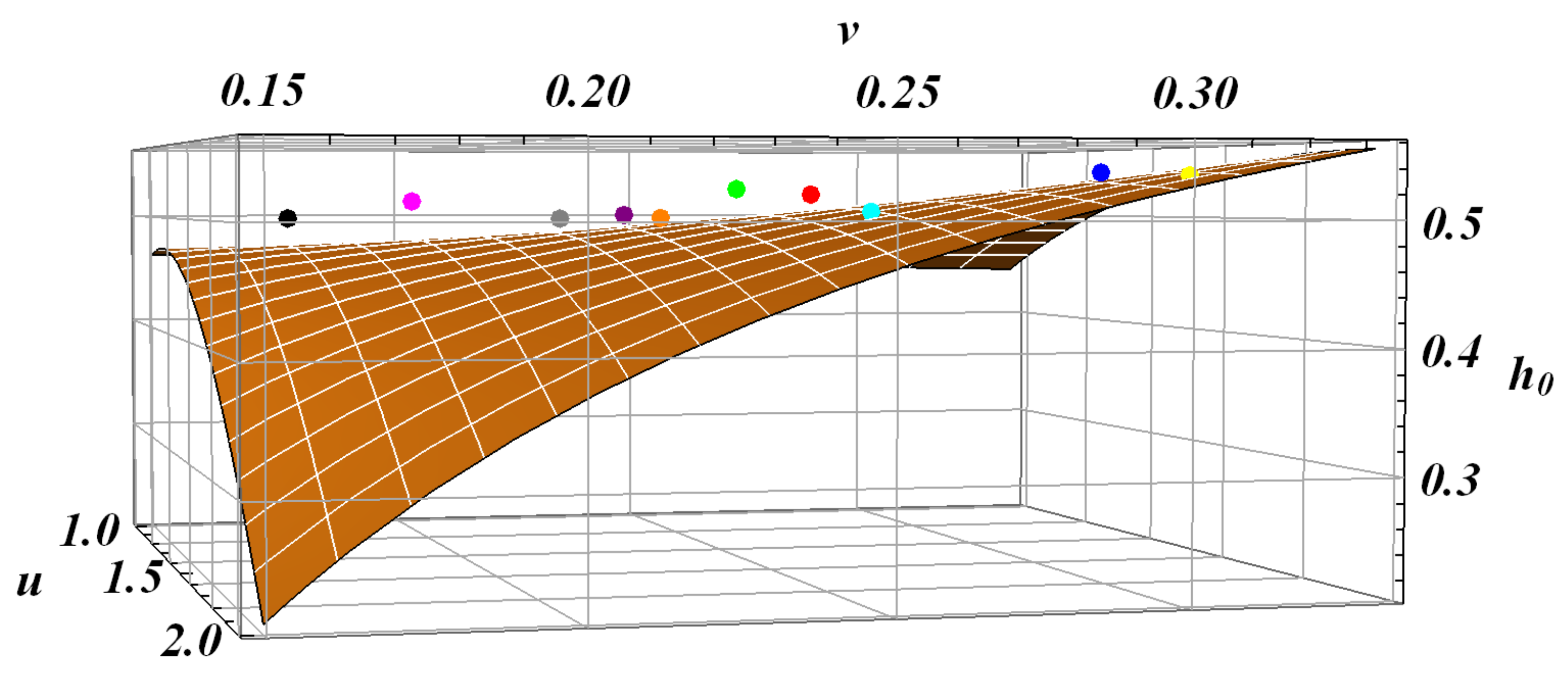Revisiting Wilf’s Question for Numerical Semigroups S3 and Inequalities for Rescaled Genera
Abstract
1. Introduction
2. Syzygy Identities for Numerical Semigroups
2.1. Lower Bound of
2.2. Lower and Upper Bounds of
2.3. Wilf’s Question for
2.4. Lower and Upper Bounds of Rescaled Genera ,
2.5. Rescaled Genera in Symmetric Semigroups
3. Concluding Remarks
- The set of exceptional numerical semigroups , similarly to (27), with and exceeding their critical values, must be finite; otherwise a direct verification becomes impossible.
Funding
Data Availability Statement
Acknowledgments
Conflicts of Interest
References
- Wilf, H.S. Circle-of-lights algorithm for the “money–changing problem”. Amer. Math. Mon. 1978, 85, 562–565. [Google Scholar] [CrossRef]
- Fröberg, R.; Gottlieb, C.; Häggkvist, R. On numerical semigroups. Semigroup Forum 1987, 35, 63–83. [Google Scholar] [CrossRef]
- Dobbs, D.; Matthews, G. On a question of Wilf concerning numerical semigroups. In Focus on Commutative Rings Research; Nova Science Publishers: New York, NY, USA, 2006; pp. 193–202. [Google Scholar]
- Moscariello, A.; Sammartano, A. On a conjecture by Wilf about the Frobenius number. Math. Z. 2015, 280, 47–53. [Google Scholar] [CrossRef]
- Eliahou, S. Wilf’s conjecture and Macaulay’s theorem. J. Eur. Math. Soc. 2018, 20, 2105–2129. [Google Scholar] [CrossRef]
- Delgado, M. Conjecture of Wilf: A survey. In Numerical Semigroups; Springer INdAM Series; Springer: Cham, Switzerland, 2020; Volume 40, pp. 39–61. [Google Scholar] [CrossRef]
- D’Anna, M.; Moscariello, A. Bounds for invariants of numerical semigroups and Wilf’s conjecture. Math. Z. 2023, 304, 35. [Google Scholar] [CrossRef]
- Fel, L.G. Restricted partition functions and identities for degrees of syzygies in numerical semigroups. Ramanujan J. 2017, 43, 465–491. [Google Scholar] [CrossRef]
- Fel, L.G. Genera of numerical semigroups and polynomial identities for degrees of syzygies. In Combinatorial and Additive Number Theory V; Springer Proceedings in Mathematics & Statistics; Springer: Cham, Switzerland, 2022; Volume 396, pp. 153–178. [Google Scholar] [CrossRef]
- Hardy, G.H.; Littlewood, J.E.; Polya, G. Inequalities; Cambridge University Press: Cambridge, UK, 1934. [Google Scholar]
- Davison, J.L. On the linear Diophantine problem of Frobenius. J. Number Theory 1994, 48, 353–363. [Google Scholar] [CrossRef]
- Fel, L.G. Frobenius problem for numerical semigroups S3. Func. Anal. Other Math. 2006, 1, 119–157. [Google Scholar] [CrossRef]
- Rosales, J.C. Numerical semigroups with multiplicity three and four. Semigroup Forum 2005, 71, 323–331. [Google Scholar] [CrossRef]
- Herzog, J. Generators and relations of Abelian semigroups and semigroup rings. Manuscripta Math. 1970, 3, 175–193. [Google Scholar] [CrossRef]
- Bresinsky, H. On prime ideals with generic zero xi = tni. Proc. Amer. Math. Soc. 1975, 47, 329–332. [Google Scholar]


| 1.35225 | 1.07143 | 0.57143 | 0.52273 | |
| 1.25988 | 0.86363 | 0.54545 | 0.51667 | |
| 1.34840 | 1.18750 | 0.625 | 0.53704 | |
| 1.25794 | 1.04545 | 0.63636 | 0.54412 | |
| 1.28338 | 0.96428 | 0.57143 | 0.52439 | |
| 1.20605 | 0.76667 | 0.53333 | 0.51316 | |
| 1.20493 | 0.9 | 0.6 | 0.53571 | |
| 1.17074 | 0.71053 | 0.52632 | 0.51087 | |
| 1.24212 | 0.85 | 0.6 | 0.53704 | |
| 1.22644 | 0.9 | 0.6 | 0.53571 | |
| 1.19523 | 0.79167 | 0.58333 | 0.53226 | |
| 1.18322 | 0.71429 | 0.57143 | 0.52941 | |
| 1.15950 | 0.80769 | 0.61539 | 0.54412 |
Disclaimer/Publisher’s Note: The statements, opinions and data contained in all publications are solely those of the individual author(s) and contributor(s) and not of MDPI and/or the editor(s). MDPI and/or the editor(s) disclaim responsibility for any injury to people or property resulting from any ideas, methods, instructions or products referred to in the content. |
© 2025 by the author. Licensee MDPI, Basel, Switzerland. This article is an open access article distributed under the terms and conditions of the Creative Commons Attribution (CC BY) license (https://creativecommons.org/licenses/by/4.0/).
Share and Cite
Fel, L.G. Revisiting Wilf’s Question for Numerical Semigroups S3 and Inequalities for Rescaled Genera. Mathematics 2025, 13, 3771. https://doi.org/10.3390/math13233771
Fel LG. Revisiting Wilf’s Question for Numerical Semigroups S3 and Inequalities for Rescaled Genera. Mathematics. 2025; 13(23):3771. https://doi.org/10.3390/math13233771
Chicago/Turabian StyleFel, Leonid G. 2025. "Revisiting Wilf’s Question for Numerical Semigroups S3 and Inequalities for Rescaled Genera" Mathematics 13, no. 23: 3771. https://doi.org/10.3390/math13233771
APA StyleFel, L. G. (2025). Revisiting Wilf’s Question for Numerical Semigroups S3 and Inequalities for Rescaled Genera. Mathematics, 13(23), 3771. https://doi.org/10.3390/math13233771








